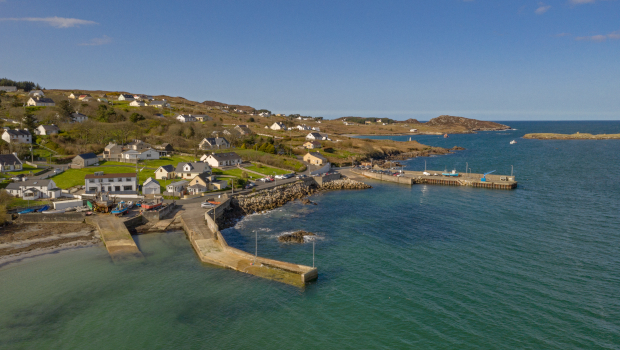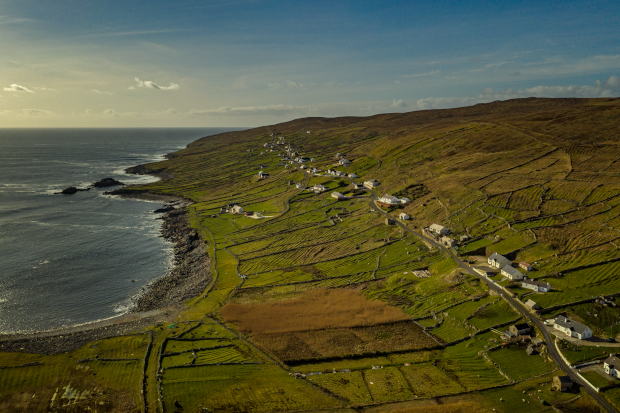
Sensing change: IoT uncovers insights for life and work on Arranmore
As an island located in the Atlantic Ocean at the most North-Westerly point in Europe, every facet of life on Arranmore is exposed to the elements. Knowing the weather patterns, and being able to anticipate and respond to them, is vital for so much of day-to-day living on the island, from its fishing industry to ferry crossings. It also affects the summer tourism activities that the island relies on for much of its residents livelihoods.

Arranmore’s relatively small landmass of just 22km sq belies a surprisingly varied and highly changeable climate. A visitor arriving by ferry at Leabgarrow might be greeted by clouds, but during the short distance to the far side of the island, this becomes driving rain, which gives way to thick fog by the time they reach the lighthouse on the northern tip. Until recently, Arranmore didn’t have its own dedicated weather station, and relied on readings taken from two Met Éireann stations in mainland Donegal.
But Arranmore islanders have embarked on a wide-ranging project to increase the sustainability of life on the island, and promote it as a destination for tourists and returning native islanders. As part of this, Arranmore upgraded its wireless connectivity in partnership with Three. The next step was to seek out useful technologies that could take advantage of the high-speed network and help the islanders in their goal.
Weather report
Not surprisingly, the natural environment emerged as a recurring theme in the discussions. Weather conditions affect every activity on Arranmore: during heavy wind and rain, ferry crossings are cancelled. When the seas are choppy, the island’s fishermen can’t go about their work. “Islanders are a lot more in touch with the environment… you’re surrounded by the sea, so it’s important to be able to monitor those sorts of things,” says Seamus Bonner of Arranmore Community Council.

When Arranmore residents met with the team from Three to discuss how they could use IoT, they were determined that these technologies would help them with the challenges of day-to-day island life. Just as they would do with any enterprise, the IoT team used white boards to discuss ideas with the islanders and draw up a priority list for where to apply IoT to best effect. “The main focus we had was that there would be practical solutions that would benefit the community on the island, and not just be a research project,” says Seamus.
Now, a weather station near Arranmore’s main helipad gives more accurate and up-to-date information about climate on the island. By sensing air pressure and temperature changes, the sensor will be able to gauge the strength of approaching storm fronts, for example. Data from the sensor at the helipad will also be available to the medivac helicopter pilots. “Having more accurate forecasts is very useful for everyone on Arranmore. It’s an island so if the weather is hampering ferry crossings, it can be useful to have a weather station,” says Seamus.
Another suggestion from the discussions was to install a water quality and tide gauge. This will benefit the island’s fishing industry and its tourist business. At high season, the population of Arranmore swells from 469 residents to almost 1,000, so the gauge will also benefit the island’s seasonal tourism activities such as sailing and kayaking, and marine tourism heritage tours.
For the record
There are 30 sensors located around the island, gathering information about the environment. “We have quite a number of the public buildings that have sensors recording temperature, occupancy, electricity use and air quality and then the weather station with supplementary rainfall monitors that we’ve put around the place,” says Seamus.

While this information is very useful by itself, the project will come into its own once it lets islanders overlay data from multiple sources to build up an even more accurate picture. For example, combining local environmental information with data from forecasters tracking storms, could allow for more accurate predictions of weather events.
Three is currently building a repository to hold the data. When that’s ready, islanders will be able to log into a web portal and see an easy-to-understand visual dashboard that interprets the data gathered from the sensors on the island. What they see will vary depending on what information they want to look at. The team is also looking to make the data available through an app.
Diving deeper to get to insight
And that’s just the beginning, says Seamus. “What’s really interesting for us is the ability to overlay data of different types. We have a footfall monitor and can compare that with weather data, or if there was an event on the island, we can see how many people came to the event,” he says. Having access to footfall patterns will also help local businesses to manage their costs more effectively, so that a shop can stock more products for the time of year when the island’s visitor numbers are at their highest. The ferry operator could also look at organising extra crossings for busy periods, based on hard data that the sensors provide.
As often happens with IoT projects, the information will quickly start showing value beyond what was originally envisaged. Arranmore school will be able to use data from the environmental monitor, water and electricity consumption patterns to help it to apply for ‘green flag’ status. “We also have a CoderDojo on the island, so hopefully the children can start using the data to come up with new and useful applications,” Seamus adds.
Proving ground
Arranmore’s IoT project is in its very earliest stages, so it will take time for patterns to emerge, which is when even deeper insights will start to become clear. Looking beyond Arranmore, there are many potential use cases for the particular kinds of sensors being trialled on the island. Utility companies are interested in IoT because it would allow them to install sensors on customer equipment that gives them greater insight into consumption patterns, while saving on the manual resources needed to physically check meters.
These types of devices only need to produce one reading a day and then go back to ‘sleep’ so they don’t consume much bandwidth. Although they need very little power to carry out this task, the devices still need a battery life that lasts well over 15 years, since they are often installed in hard-to-reach places like basements or embedded in the ground.
The devices deployed on Arranmore look set to deliver lessons about applying IoT in many different contexts.
If you are interested in learning more about how Three Business are transforming the island of Arranmore, visit our dedicated website three.ie/theisland
Seamus Bonner is a member of Arranmore Community Council, and Shane McHugh, IoT Product Manager at Three






Subscribers 0
Fans 0
Followers 0
Followers